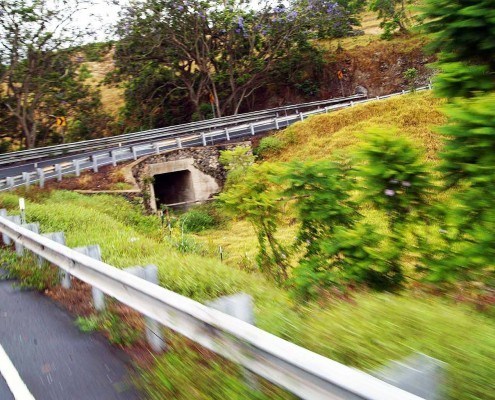
Car Sickness Causes And Remedies
Causes Of Car Sickness
Anyone can get car sickness. It’s caused by the mixed signals the brain can experience when the motion one is feeling does not match the visual experience. If you cannot see the motion your body is feeling, or vice versa, it becomes likely that the brain will get mismatched signals and possibly develop symptoms of motion sickness.
Some are more susceptible to motion sickness than others such as young children ages 5 to 12 years old, women (especially if pregnant), and older adults. It is rare in children under 2. It can be a severe problem for many whether traveling in a boat or plane but the majority of people experience motion sickness from vehicle travel – especially on winding roads with lots of blind curves.
If you’re traveling with kids who experience car sickness this can also add to the chaos – making for a less than desirable travel experience for all.
First Signs That You are Getting Car Sick
One of the first signs of car sickness is lots of yawning with increasing irritability. Other symptoms include a feeling of uneasiness followed by cold sweats and dizziness. People experiencing the first stages of car sickness may exhibit increased saliva production, pale looking skin, headaches, fatigue and sleepiness with the eventual possibility of nausea and vomiting.
CNN’s Dr Sanjay Gupta explains there are some who are more at risk of experiencing car sickness than others.
Q – Are some people more susceptible to car sickness than others?
CNN’s Dr Sanjay Gupta: “People who have some sort of inner ear problem, we know that that can be an issue. Someone who has difficulty with their vision is more likely to have that mismatch between what they see and what they’re feeling in their inner ear. Diabetics – because they have numbness in the feet – often times won’t be able to tell if they’re moving when they are, so they’ll get a mismatch. There have been some studies that have shown that genetics play a role so that if your mother gets motion sick, you’re more likely to, but … there’s a pretty weak association, genetically.”
If you’re on vacation driving along winding roads add to the fact that you may be driving in unfamiliar territory which can add to the anxiety level and lead to the onset of symptoms.
These easy tips may help you feel better if you’re experiencing car sickness:
Tip #1 – Don’t drink alcohol or eat a heavy meal before beginning a challenging road trip.
Tip #2 – Ginger candies or tea can calm an uneasy stomach.
Tip #3 – Stop often and get some fresh air.
Tip #4 – Sit where you have plenty of visibility, especially of the horizon.
Tip #5 – Sip on clear, fizzy drinks such as ginger ale.
Tip #6 – Eat a few dry soda crackers.
Tip #7 – Move your head as little as possible.
Ways To Avoid Car Sickness
It’s best to try and avoid car sickness in the first place as once symptoms start they become difficult to overcome. Taking medications or natural remedies an hour or more before travel can help prevent symptoms for some. Looking out at the horizon can prevent the visual mismatch that can be a cause of symptoms for some.
Some also suggest it is best to do the driving if you’re prone to car sickness. Many believe it can give you the added stability of holding on to the wheel and anticipating turns and bumps.
Though this may work for some, keep in mind there is often the added stress of driving a crowded or narrow road (many scenic drives are like this) and not being sure about where to stop and for how long. Again, not a relaxing vacation or travel situation trying to deal with carsickness and being lost.
One of the best solutions is to take a guided van tour if one is available. Being able to relax and let a professional driver familiar with the road do the driving can make a big difference. Letting a guide know you’re prone to car sickness before the tour can signal them to take it easy and stop often for you. The larger windows of a tour van are also helpful as you can see more of the horizon and less of the roadside vegetation whizzing by because they sit higher off the ground than a car.
Many eco-tour operators are also knowledgeable about local flora and fauna, the culture and history of the region and can give guests exclusive information about the area they’re staying in such as where else to go and what to do from a local perspective.
Guides who drive scenic destination tours also have local knowledge about road conditions. Guides are trained to drive safely on these often remote roads with passenger comfort in mind, unlike many spouses or family members who may just want to “get there quickly”. Also well trained guides can recognize the symptoms of car sickness and how to help, whether it’s a local remedy, driving technique or length of stops.
Car Sickness Medications
According to webmd.com it’s best to try to prevent car sickness, because symptoms are hard to stop after they start. After symptoms start, you may feel better only after the motion stops.
There are plenty of over the counter medications to consider depending on the severity of your car sickness. Though many people experience relief from these drugs keep in mind there are side effects which usually include drowsiness.
Over the counter medications containing meclizine (Bonine, Antivert, Dramamine) can be an effective preventive measure for some on short trips or for mild cases of car sickness. Most need to be taken an hour or more before venturing out on a challenging road trip.
Your doctor may also choose to prescribe medications for longer trips or if you repeatedly develop severe car sickness. One example of a prescription medication is a patch containing scopolamine (Transderm-Scop) that can be effective in preventing car sickness. Remember that scopolamine can cause drowsiness and has other side effects, and its use should be discussed with your physician prior to your trip. Most drugs should be taken an hour or more before heading out on a road trip.
Natural Remedies
Many people prefer natural remedies to drugs and there are plenty of tried and true ways to reduce or prevent symptoms of car sickness. Tripadvisor has some informative forums where people discuss what car sickness remedies work for them while traveling the world’s winding roads. Some have suggested several or all of these things can be combined.
Ginger – This is a fairly common remedy for motion sickness and nausea. It can be taken in many forms to be helpful. Try chewing on ginger candies or eating ginger cookies. Slowly sipping ginger tea or all natural ginger soda can calm the feeling of nausea. Ginger tablets or capsules can help and, like drugs, work best if taken about an hour before traveling. (If you are pregnant or taking blood thinners you should consult your trusted healthcare provider before taking ginger.)
Breathing – A good line of defense against motion sickness is taking deep breaths. It helps with an upset stomach and reduces dizziness. Breathing slowly and deeply can give you relief on a short trip and help you to relax overall.
Focus your eyes – Car sickness is exacerbated when you are watching things whizz by at what feels like high speeds. It helps to focus on the road ahead, the horizon, or a stationary object in the distance. Keeping your body still with your head facing forward is important so the brain and inner ear can sync up. This helps avoid the dizziness and nausea associated with car sickness. The more you can visually see the better your odds of avoiding these symptoms.
Acupressure wristbands – These wristbands are specially designed and work by applying pressure to the inside of the wrist at the Nei-Kuan point. Stimulation of this acupressure point can reduce nausea. These bands can be purchased online, in drugstores, and some large grocery chains. Also you can try making your own with a large rubber band and small pebble or bead. Just make sure to place it in the correct position.
Peppermint – You can put a few drops of peppermint essential oil on a handkerchief and wave it in front of your nose while inhaling. Sucking on peppermint candies or drinking a strong cup of peppermint tea is also effective for some.
Guide vs Driving Yourself
According to a multitude of travel polls several of the top scenic drives in the world are located on the Hawaiian Island of Maui. As a top tourist destination it can be a busy place with slow moving traffic. This can be frustrating if you’re used to driving on freeways and it can be a surprise to realize how long it can take to travel from one side of the island to another. The ruggedness and challenges of driving Maui’s roads is offset by the sheer beauty of the island so keep in mind to slow down and enjoy the easy going flow of island life. The road to Hana especially has it’s own unique challenges. It’s important to learn the driving etiquette involved with this road.
The main highways have been upgraded in the last few years in Maui especially the widened highway between the airport in Kahului and Kihei, which extends to Wailea, on the southern shore. Also Haleakala Highway heading upcountry from Kahului has been widened to two lanes both directions and was resurfaced with concrete. Other than this though most of the island’s roads are narrow with little shoulder-way.
When you travel with a tour guide they understand the road conditions, drive times, and ways to get around traffic snarls. Guides can also share information about other areas of the destination you may want to explore on your own. Plus you can figure by the end of the day you will have a new friend – local tour guides are as much entertainers as they are historians and storytellers!
Traveling Scenic Roadways
We all travel to see new things. The same is true whether we travel by plane, boat or car. Those who struggle with motion sickness have often tried many techniques to relieve symptoms so they can see and experience scenic and remote locations around the world. Though we discuss many of the most common remedies there is one that some forget to consider – taking a guided van tour.
Maui’s Road to Hana
In Maui there are two roads that approximately 1 million people venture out on every year. Both of them lead to different sections of Haleakala National Park
The longest of these two roads, the road to Hana, circles the entire eastern side of the island. These scenic drives are often the highlight of every Maui vacation!
This narrow winding road is over 70 miles long and circumnavigates the base of Haleakala Volcano which makes up 75% of Maui’s land mass. With over 50 one lane bridges and 600+ hairpin turns it is one of the most challenging as well as beautiful road trips in the world – especially if you are prone to car sickness. However it is truly a journey not to be missed! One of the best ways to travel this road is with a guide. They make frequent stops – more than you may on your own – because a guide knows where the most interesting things to see are. It’s one of the keys to avoiding car sickness.
Doing the full loop of the Hana highway will take around 10 to 12 hours. Since it’s one road in and out it really doesn’t make much sense to go to Hana or the Pools of Oheo (part of Haleakala National Park) and back on this super winding road. It’s best to do what the tours do, go all the way around one way.
Haleakala’s Crater Road
Though not as long as the road to Hana, the drive up crater road to the top of Haleakala volcano is also a winding switchback road running 38 miles from sea level to 10,000 ft elevation. This is one of the fastest ascents of this elevation gain in the world! This can be a problem for some as it’s a combination of lots of blind turns and possible elevation sickness.
The views from this road are amazing and encompass the four nearby islands of Kahoolawe, Lanai and Molokai to the west and the Big Island of Hawai’i to the east. At the summit the view into this 7 mile long, 2 mile wide and 3000 ft deep crater is stunning! Tens of thousands of people a year travel to the summit for sunrise. It’s one of the most popular things to do but keep in mind you’ll be driving up these switchbacks in the dark, with thousands of other cars! Again, if you take a tour you can relax, even nap, on the way up and be brought back to your hotel or condo relaxed and ready to enjoy the rest of the day…








